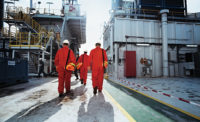“Like Mother Jones used to say, ‘mourn for the dead, but fight like hell for the living,’ is what we are doing every day,” OSHA Administrator Dr. David Michaels told the more than 3,500 occupational safety, health and environmental professionals at the annual American Society of Safety Engineers (ASSE) Professional Development Conference in Baltimore, Md., according to an ASSE press release.
He addressed issues involving work safety in the Gulf involving the BP oil spill, ineffectiveness of incentive safety programs, criminal penalties for fatal worker injuries, chemical standards, distracted driving, high state and city worker injury rates, combustible dust, OSHA’s top priorities, resources and citations.
When it comes to criminal penalties for the loss of workers, Dr. Michaels noted his concern. “Recently a worker died while cleaning a container,” Dr. Michaels said. “I believe the employer was slapped with a $175,000 fine. But what gets me is that the same company was fined $10 million dollars for the same incident for causing pollution and negatively hurting the fish and crabs. So how do we tell the family of this worker who died that fish and crabs are worth more than his life?
“We need to fix this,” he told the audience who clapped. “Currently, I believe the maximum sentence for an employer who willfully ignores workplace safety rules and regs and prevention efforts and one of their employees dies on the job, is six months in jail. However, if you harass a burro on federal land you can get a year in jail. Does that make sense?”
Michaels said they have thousands of OSHA workers in the Gulf helping monitor the occupational safety and health risks for the clean-up workers.
“We have about 17,000 workers helping with the BP oil spill clean-up. We are on land and in boats all over the area checking for and providing solutions to possible harmful exposures to the clean-up workers such as chemicals, heat and fatigue. If we find any we tell BP and they correct them,” Michaels said. “We’re not there to hand out citations, but to protect workers — prevent injuries and illnesses.”
An area where many agree on is the Protect America’s Workers Act (PAW) now in Congress which would provide, as part of the legislation, occupational safety and health coverage for state and local workers countrywide and for federal workers. ASSE members and Dr. Michaels noted that local and state workers have much higher injury rates than the private sector. One ASSE member agreed that they were bad, especially in one city he worked in.
When asked what his top priorities for OSHA are Michaels responded, “First is reducing injuries and illnesses and developing a prevention program; second is the modernization of the injury recording process; and third is to reshape the way OSHA works to develop a targeting system to better identify those employers who ignore workplace safety and health regulations and put their workers at peril.”
He closed the session by noting that OSHA and the U.S. Coast Guard have a memo of understanding when it comes to addressing clean-up efforts in the Gulf in an effort to protect workers and keep the clean-up activities moving forward.
“Remember, our number one objective is protecting workers,” Dr. Michaels said.
OSHA chief responds to questions on Gulf oil spill clean-up, workplace fatality penalties, top priorities (6/16)
Looking for a reprint of this article?
From high-res PDFs to custom plaques, order your copy today!





